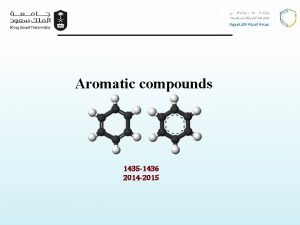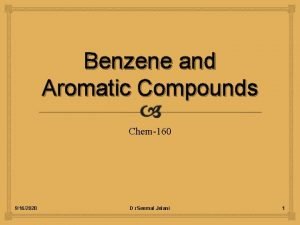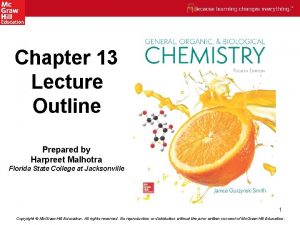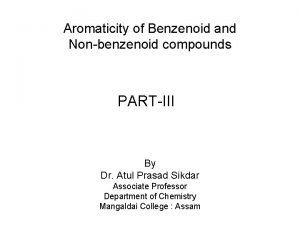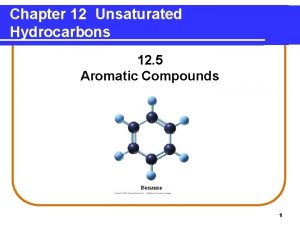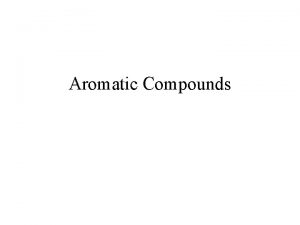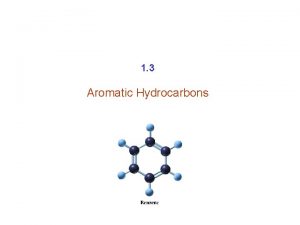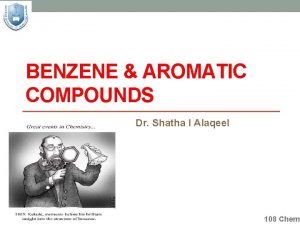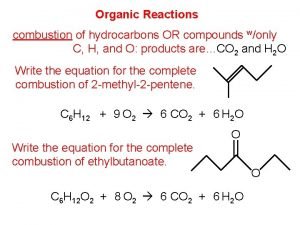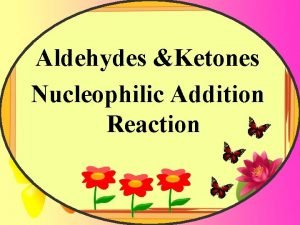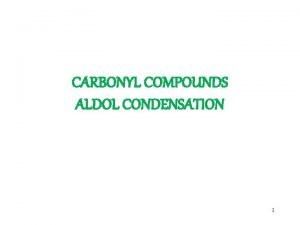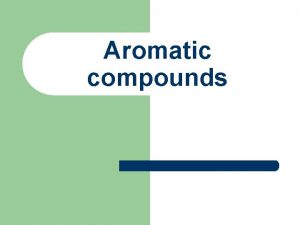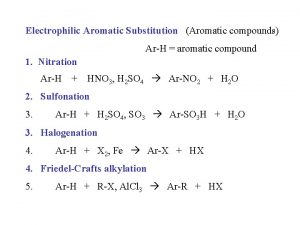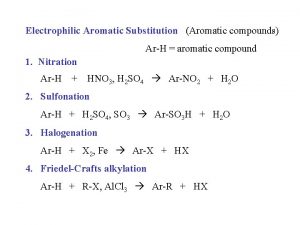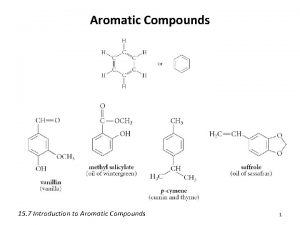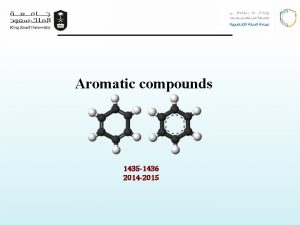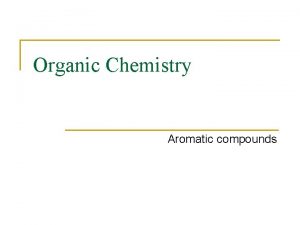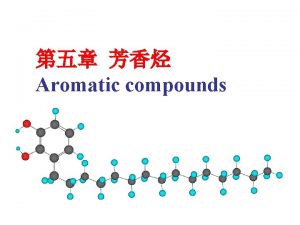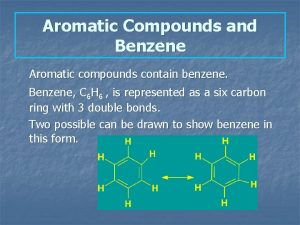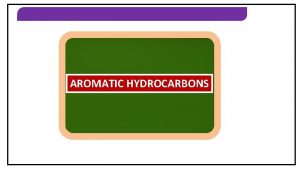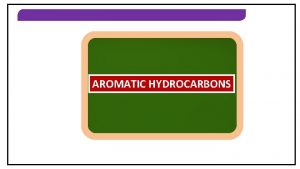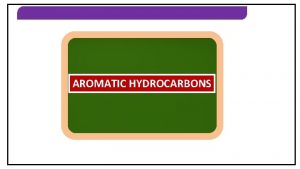AROMATIC COMPOUNDS REACTIVITY TYPICAL REACTION OF AROMATIC COMPOUNDS















- Slides: 15

AROMATIC COMPOUNDS - REACTIVITY TYPICAL REACTION OF AROMATIC COMPOUNDS - SUBSTITUTION ELEKTROPHILIC AROMATIC Mechanizm of substitution electrophilic aromatic E reaktion coordinate

AROMATIC COMPOUNDS - REACTIVITY Aromatic compounds are forming complexes - crystaline compound - X-ray analysis - when heated it decomposes back

AROMATIC COMPOUNDS - REACTIVITY Preparation of electrophilic reagents HALOGENATION is limited to chlorination and bromination For the reaction Lewis acid is necessary similarly aluminium halogenide is active, sometimes addition of powdered metal is used reactive aromates Fluorination as SEAr is not applied, is carried out as Schiemann reaction (by decomposition of aromatic diazonium salts) Iodine is less active and therefore elektrophilic reagent I+ is generated directly in reaction mixture by iodine oxidation by H 3 As. O 4 , HNO 3

AROMATIC COMPOUNDS - REACTIVITY NITRATION - Nitration of activated aromatic systems is possible even by HNO 3 - I case of substituted derivatives it is necessary to také to consideration reaction of substituents with strong acid SULFONATION conc. sulfuric acid, oleum, sufur trioxide the reagent is sulfur trioxide Sulfonation is reversible reaction Conditions: conc. acid, oleum diluted acid + steam (overheated)

AROMATIC COMPOUNDS - REACTIVITY FRIEDEL –CRAFTS reaction – alkylation and aryltion (1877 – Friedl (F), Crafts (US) ALKYLATION Differnt Lewis acids: Al. Cl 3, BF 3, Ti. Cl 4, Sn. Cl 4, Zn. Cl 2, but also acids HF, H 2 SO 4 Alkylation agents may be also alcohols and alkenes:

AROMATIC COMPOUNDS - REACTIVITY FRIEDEL –CRAFTS reaction – alkylation and aryltion (1877 – Friedl (F), Crafts (US) ALKYLATION Conditions and restrictions: 1) Reactions cannot be applied at aromatic systems with strong electronwithdrawing groups (-NO 2, -NH 3+, - CN) 2) Halogen derivatives and vinyl derivatives do not work. 3) The formed alkylated system is always more reactive than the starting compound a severalfold substitution can be observed 4) When you are trying alkylation with a longer chain – when carbocation is formed, often its rearrangement to the more stable cation is observed 5) Reactions cannot be applied at aromates with amino group because amino group interacts with Lewis acid forming complex with free electron pair of nitrogen and this way is desactivating aromatic system

AROMATIC COMPOUNDS - REACTIVITY FRIEDEL –CRAFTS reactions ACYLATION - formation of aromatic ketones

AROMATIC COMPOUNDS - REACTIVITY REIMER – TIEMAN reaction dichlorkarben je electrophile o- and p-substituted hydroxybenzaldehydes are formed

AROMATIC COMPOUNDS - REACTIVITY CHLORMETHYLATION - introduction of chlormethyl group

AROMATIC COMPOUNDS - REACTIVITY AZOKOPULATION - formation of azodyes

AROMATIC COMPOUNDS - REACTIVITY REACTIONS AT SUBSTITUTED AROMATICS - influence of substitution STATISTICS: o- 40% m- 40% p- 20%

AROMATIC COMPOUNDS - REACTIVITY

AROMATIC COMPOUNDS - REACTIVITY

AROMATIC COMPOUNDS - REACTIVITY Donating o- and pdirecting substituents Strongly activating Weak activating desactivating m - directing For the quantitative value of substituent influence consult Hammett constants

AROMATIC COMPOUNDS - REACTIVITY
 Benzene naming priority
Benzene naming priority Aromatic compounds huckel rule
Aromatic compounds huckel rule Aromatic compounds undergo
Aromatic compounds undergo Aromaticity in benzenoid and non benzenoid compounds
Aromaticity in benzenoid and non benzenoid compounds Unsaturated aromatic compounds
Unsaturated aromatic compounds Which of the following compounds is aromatic?
Which of the following compounds is aromatic? Aromatic compounds
Aromatic compounds Examples of non aromatic compounds
Examples of non aromatic compounds Ionic metallic and covalent bonds venn diagram
Ionic metallic and covalent bonds venn diagram Combustion of pentene
Combustion of pentene Ag(nh3)2 reaction with aldehyde
Ag(nh3)2 reaction with aldehyde Condensation reaction of carbonyl compounds
Condensation reaction of carbonyl compounds Reaction rate equation
Reaction rate equation Ictahedron
Ictahedron Half-life formula
Half-life formula Leukoerythroblastic reaction vs leukemoid reaction
Leukoerythroblastic reaction vs leukemoid reaction
